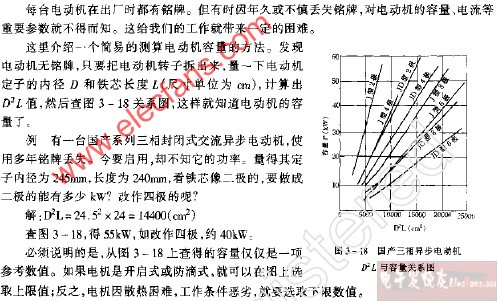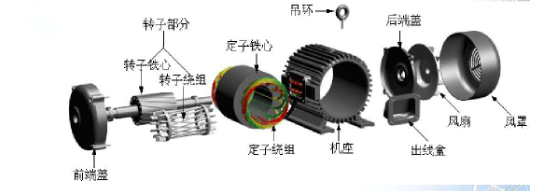教學(xué)目標(biāo)
??了解電動(dòng)機(jī)容量選擇的基本理論。
??掌握電力拖動(dòng)系統(tǒng)中電動(dòng)機(jī)容量選擇的工程方法 。
5.1 The choice of Motor
??There are many factors which must be considered when choosing a motor for a particular drive. In the following notes, the main points are highlighted but the final choice is usually a matter for the specialist. Not all the factors can be dealt with here, but the summary notes, together with the relevant sections of the main text, will be sufficient to give a good appreciation of the general problem.
??The solution of this problem is not usually unique and opinions may differ widely in some cases as to he most suitable motor-drive system. However, it may be said in brief that the correct motor is the one which meets the required specification at minimum cost, but this is not a simple matter to estimate. It must include not only the capital cost of the motor-drive system itself but also the running costs. The capital cost includes the provision of any special supplies find control gear to run the motor.
??The running cost includes interest, charges on capital equipment and buildings and charges for the power losses consumed in the machine and control circuits; obviously power factor and efficiency are of significance here. Maintenance is also a regular running cost and would normally be higher with complex control gear and with machines having rubbing contacts at slip rings and commentators. Installation costs too may be decisive; for example, special foundations are required for motor-generator sets but not for static conversion equipment. Such equipment also makes less demands on space and is less noisy than rotating machinery. On the other hand, there is considerable harmonic generation which poses a suppression problem.
??Some motors are excluded from a particular application because the operating environment is "hostile" in some way, as in conditions of high temperature, high vacuum, high speed or in the presence of corrosive liquids, A brushless type of machine then becomes essential. Induction motors are generally the cheapest type off machine especially if a single, cage rotor is satisfactory. The price increases as more demands are made on the control side and which might necessitate a wound-rotor machine.
??Even then the power factor remains poor unless correction is applied, and the brushless synchronous machine may therefore become competitive. If simple, infinitely-variable speed-control is required, then a.c. or d.c. commutator machines are called for, unless a variable-frequency supply with induction or synchronous motors can be justified. This special supply could be partly offset against the cost of d.c. or variable-voltage a.c. apparatus required for commutator machines
§ 電動(dòng)機(jī)的一般選擇
????電動(dòng)機(jī)種類(機(jī)種)的選擇
????主要種類:電力系統(tǒng)中拖動(dòng)生產(chǎn)機(jī)械運(yùn)行的原動(dòng)機(jī)即驅(qū)動(dòng)電機(jī),包括直流電動(dòng)機(jī)和交流電動(dòng)機(jī)兩種。交流電動(dòng)機(jī)又有異步電動(dòng)機(jī)和同步電動(dòng)機(jī)兩種。
????種類選擇時(shí)考慮的主要內(nèi)容
????電動(dòng)機(jī)的機(jī)械特性:生產(chǎn)機(jī)械具有不同的轉(zhuǎn)矩轉(zhuǎn)速關(guān)系,要求電動(dòng)機(jī)的機(jī)械特性與之相適應(yīng)。
????電動(dòng)機(jī)的調(diào)速性能:調(diào)速范圍、調(diào)速的平滑性、調(diào)速系統(tǒng)的經(jīng)濟(jì)性都應(yīng)該滿足生產(chǎn)機(jī)械的要求。
????電動(dòng)機(jī)的起動(dòng)性能
????電源
????經(jīng)濟(jì)性
????綜合觀點(diǎn):以上各方面在旋轉(zhuǎn)電動(dòng)機(jī)時(shí)必須都考慮到,都得到滿足后才能選定;能同時(shí)滿足以上條件的電動(dòng)機(jī)可能不是一種,還應(yīng)綜合其他情況,諸如節(jié)能、貨源等加以確定。
????安裝方式:臥式、立式
????軸伸個(gè)數(shù):伸出到端蓋外面與負(fù)載聯(lián)接的轉(zhuǎn)軸部分,稱為軸伸。分為單軸伸和雙軸伸。
????防護(hù)方式:開啟式、防護(hù)式、封閉式和防爆式幾種。
????開啟式電動(dòng)機(jī),在定于兩側(cè)與端蓋上都有很大的通風(fēng)口。散熱好,價(jià)格便宜,但容易進(jìn)灰塵、水滴、鐵屑等雜物。只能在清潔、干燥的環(huán)境中使用。
????防護(hù)式電動(dòng)機(jī),在機(jī)座下面有通風(fēng)口。散熱好,能防止水滴、鐵屑等從上方落入電機(jī),但不能防止潮氣和灰塵侵入。適用于比較干燥、沒有腐蝕性和爆炸性其他的環(huán)境。
????封閉式電動(dòng)機(jī),機(jī)座和端蓋上均無通風(fēng)孔,完全是封閉的。又分為自冷式、自扇冷式、他扇冷式、管道通分式及密封式。
????防爆式電動(dòng)機(jī)適用干有易燃、易爆氣體的場(chǎng)所,如礦井、油庫、煤氣站等。
????電動(dòng)機(jī)額定電壓和額定轉(zhuǎn)速的選擇
????額定電壓的選擇:電動(dòng)機(jī)等級(jí)、相數(shù)、頻率都要與供電電壓一致。
????額定轉(zhuǎn)速的選擇:對(duì)電動(dòng)機(jī)本身而言,額定功率相同的電動(dòng)機(jī)額定轉(zhuǎn)速越高,體積越小,造價(jià)越低,一般說電動(dòng)機(jī)轉(zhuǎn)子越細(xì)長,轉(zhuǎn)動(dòng)慣量越小,制動(dòng)時(shí)間短。
????當(dāng)生產(chǎn)機(jī)械所需額定轉(zhuǎn)速一定的前提下,一般來講若還需要傳動(dòng)機(jī)構(gòu)減速,則電動(dòng)機(jī)額定轉(zhuǎn)速越高,傳動(dòng)機(jī)構(gòu)速比越大,機(jī)構(gòu)越復(fù)雜,而且傳動(dòng)損耗也越大。通常電動(dòng)機(jī)額定轉(zhuǎn)速不低于 500r/min 。
????不需要調(diào)速的高、中速機(jī)械:如泵、鼓風(fēng)機(jī)、壓縮機(jī)可選相應(yīng)額定轉(zhuǎn)速的電機(jī),而不需要減速機(jī)構(gòu);
????不需調(diào)速的低速機(jī)械:如球磨機(jī)、破碎機(jī)、某些化工機(jī)械等可選用相應(yīng)轉(zhuǎn)速的電動(dòng)機(jī)或有較小速比的減速機(jī)構(gòu)。
????調(diào)速要求不高的各種生產(chǎn)機(jī)床,則可選擇轉(zhuǎn)速稍高的電動(dòng)機(jī)配以減速機(jī)構(gòu)或選多級(jí)電動(dòng)機(jī)。
????調(diào)速要求較高的生產(chǎn)機(jī)械應(yīng)考慮生產(chǎn)機(jī)械最高轉(zhuǎn)速與電動(dòng)機(jī)最高轉(zhuǎn)速相適應(yīng),直接用電氣調(diào)速。
5.2 電動(dòng)機(jī)的發(fā)熱與溫升
????電動(dòng)機(jī)溫度比環(huán)境溫度高出的值稱為溫升。
????一旦有了溫升,電動(dòng)機(jī)就要向周圍散熱;溫升越高、散熱越快。當(dāng)電動(dòng)機(jī)單位時(shí)間發(fā)出的熱量等于放出的熱量時(shí),電動(dòng)機(jī)溫度不再增加,而保持著一個(gè)穩(wěn)定不變的溫升,即處于發(fā)熱與散熱平衡的狀態(tài)。
????以上是一個(gè)溫度升高的熱過渡過程,稱之為發(fā)熱。
????分析熱過渡過程有以下假設(shè):
(1) 電動(dòng)機(jī)長期運(yùn)行,負(fù)載不變,總損耗不變;
(2) 電動(dòng)機(jī)本身各部分溫度均勻;
(3) 周圍環(huán)境溫度不變。
????熱容量越大,熱慣性越大,時(shí)間常數(shù)也越大;散熱越快,達(dá)到熱平衡狀態(tài)就越快,時(shí)間常數(shù) 則越小。
????一臺(tái)負(fù)載運(yùn)行的電動(dòng)機(jī),在溫升穩(wěn)定之后,如果減少它的負(fù)載,那么電機(jī)內(nèi)損耗∑ p 及單位時(shí)間發(fā)熱量 Q 都將隨之減少。這樣一來,本來的熱平衡狀態(tài)破壞了,變成了發(fā)熱少于散熱,電動(dòng)機(jī)溫度就要下降,溫升降低。降溫的過程中,隨著溫升減小,單位時(shí)間散熱量 也減少。當(dāng)重新 達(dá)到即發(fā)熱等于散熱時(shí),電動(dòng)機(jī)不再繼續(xù)降溫,而穩(wěn)定在這個(gè)新的溫升上。這個(gè)溫升下降的過程稱為冷卻。
5.3 電動(dòng)機(jī)的額定功率
????從出力和壽命綜合考慮,要最充分使用電動(dòng)機(jī),就要讓電動(dòng)機(jī)長期負(fù)載運(yùn)行時(shí)達(dá)到穩(wěn)態(tài)溫升等于電動(dòng)機(jī)的允許溫升。
????一臺(tái)電動(dòng)機(jī)允許溫升不變時(shí),若設(shè)法提高效率,提高散熱能力,都可以增大它的額定功率。
????周期性斷續(xù)工作方式的電動(dòng)機(jī),負(fù)載時(shí)溫度升高,但還達(dá)不到穩(wěn)態(tài)溫升;停歇時(shí),溫度下降,但也降不到環(huán)境的溫度。那么每經(jīng)一個(gè)周期,電動(dòng)機(jī)的溫升都升一次降一次。
5.4 電動(dòng)機(jī)的額定功率的選擇
????“ 大馬拉小車 ” :電動(dòng)機(jī)額定功率過大,電動(dòng)機(jī)就經(jīng)常處于輕載運(yùn)行,電動(dòng)機(jī)本身的容量得不到充分發(fā)揮,同時(shí)電動(dòng)機(jī)運(yùn)行效率低、性能不好,都會(huì)增加運(yùn)行費(fèi)用。
????“ 小馬拉大車 ” :電動(dòng)機(jī)額定功率比生產(chǎn)機(jī)械要求的小,電動(dòng)機(jī)電流超過額定電流,電機(jī)內(nèi)損耗加大,效率降低是小事,重要的是影響電機(jī)的壽命,即使過載不多,電動(dòng)機(jī)的壽命也會(huì)減少較多;過載較多,會(huì)破壞電機(jī)絕緣材料的絕緣性能甚至燒毀。
????電動(dòng)機(jī)額定功率選擇的步驟
????第一步:計(jì)算負(fù)載功率 P L ;第二步:根據(jù)第一步結(jié)果,預(yù)選電動(dòng)機(jī)額定功率及其他; 第三步:校核預(yù)選電動(dòng)機(jī)。一般先校核發(fā)熱溫升,再校核過載能力,必要時(shí)校核起動(dòng)能力。
????校核過載能力是指:異步電動(dòng)機(jī)最大轉(zhuǎn)矩 T m 是否比負(fù)載可能出現(xiàn)的最大轉(zhuǎn)矩大,而且需考慮到電網(wǎng)可能出現(xiàn)電壓向下波動(dòng),按向下被動(dòng) 10 %計(jì)算。直流電動(dòng)機(jī)電樞電流最大允許是否比可能出現(xiàn)的最大負(fù)載電流大。
????校核起動(dòng)能力主要指鼠籠式異步電動(dòng)機(jī)是否能可靠起動(dòng)。 校核發(fā)熱經(jīng)常是最重要的。
???負(fù)載功率計(jì)算
????電動(dòng)機(jī)負(fù)載計(jì)算要針對(duì)具體生產(chǎn)機(jī)械的負(fù)載及效率進(jìn)行計(jì)算,這是選擇電動(dòng)機(jī)額定功率的依據(jù)。
????電動(dòng)機(jī)拖動(dòng)離心式水泵時(shí),電動(dòng)機(jī)負(fù)載功率:
![]()
????起重機(jī)主鉤由電動(dòng)機(jī)拖動(dòng),電動(dòng)機(jī)的負(fù)載功率
????常值負(fù)載:指工作時(shí)間內(nèi)負(fù)載大小不變,包括連續(xù)、短時(shí)兩種工作方式在內(nèi)的常值負(fù)載。
????電動(dòng)機(jī)三種工作方式中所規(guī)定的有關(guān)時(shí)間。
????環(huán)境穩(wěn)定為 40 ℃、電動(dòng)機(jī)不調(diào)速的前提下,按照工作方式及工作時(shí)間選擇該類電動(dòng)機(jī),那么電動(dòng)機(jī)的額定功率應(yīng)滿足
![]()
????這個(gè)條件本身是從發(fā)熱溫升的角度考慮的,因此不必再校核電動(dòng)機(jī)發(fā)熱問題了。只需校核過載能力,必要時(shí)還要校核起動(dòng)能力。
????預(yù)選電動(dòng)機(jī)額定功率時(shí),按發(fā)熱和溫升等效的觀點(diǎn)先把負(fù)載功率由非標(biāo)準(zhǔn)工作時(shí)間變成標(biāo)準(zhǔn)工作時(shí)間,即折算,然后按標(biāo)準(zhǔn)工作時(shí)間預(yù)選額定功率。
????短時(shí)工作方式負(fù)載工作時(shí)間為 t r ,最接近的標(biāo)準(zhǔn)工作時(shí)間 t rb ,預(yù)選電動(dòng)機(jī)額定功率應(yīng)滿足
![]()
????由于折算系數(shù)本身就是從發(fā)熱和溫升等效觀點(diǎn)推導(dǎo)出來的,因此經(jīng)過向標(biāo)準(zhǔn)工作時(shí)間折算后,預(yù)選電動(dòng)機(jī)肯定通過溫升、不必再校核了。
o 過載能力校核
????過載能力指電動(dòng)機(jī)負(fù)載運(yùn)行時(shí),可以在短時(shí)間內(nèi)出現(xiàn)的電流或轉(zhuǎn)矩過載的允許倍數(shù),對(duì)不同類型電動(dòng)機(jī)不完全一樣。
????對(duì)直流電動(dòng)機(jī)而言,限制其過載能力的是換向問題,因此它的過載能力就是電樞允許電流的倍數(shù) , 為允許電流,應(yīng)比可能出現(xiàn)的最大電流大。
????若預(yù)選的電動(dòng)機(jī)過載能力通不過,則要重選電動(dòng)機(jī)及其額定功率,直到通過。
o 起動(dòng)能力校核
????若電動(dòng)機(jī)為鼠籠式三相異步電動(dòng)機(jī),最后還要校核起動(dòng)能力是否通過,若通不過,也應(yīng)重選電動(dòng)機(jī)及其額定功率,直至通過。
????發(fā)熱、過載能力及起動(dòng)能力都通過了,則電動(dòng)機(jī)額定功率就確定了。
o 穩(wěn)定修正
????若環(huán)境溫度長年都比較低或比較高,為了充分利用電動(dòng)機(jī)的容量,應(yīng)對(duì)電動(dòng)機(jī)的額定功率進(jìn)行修正。電機(jī)允許輸出功率為
o 周期性變化負(fù)載連續(xù)工作方式
![]() ????
????
????負(fù)載變化,電動(dòng)機(jī)損耗也變化,負(fù)載大時(shí)電流大,電機(jī)中可變損耗與電流平方成正比,因此負(fù)載大,損耗更大。
![]() ????
????![]()
????等效轉(zhuǎn)矩法:轉(zhuǎn)速恒定時(shí),電磁轉(zhuǎn)矩 T=T L ;起動(dòng)與制動(dòng)過程中,電磁轉(zhuǎn)矩 T=T L +T a , T a 是使電力拖動(dòng)系統(tǒng)加速的或減速的轉(zhuǎn)矩,即為動(dòng)轉(zhuǎn)矩。加速時(shí)動(dòng)轉(zhuǎn)矩 T a 為正值,減速時(shí) T a 為負(fù)值。這樣,一個(gè)周期內(nèi)電動(dòng)機(jī)電磁轉(zhuǎn)矩情況便可確定了。
o 周期斷續(xù)工作方式
![]()
????周期斷續(xù)工作方式電動(dòng)機(jī)需要每個(gè)周期都起動(dòng)和制動(dòng),在工作時(shí)間 t r 內(nèi)一定是變化負(fù)載,因此預(yù)選電動(dòng)機(jī)額定功率時(shí)要按工作時(shí)間內(nèi)平均功率的 1.1 ~ 1.6 倍進(jìn)行。
????負(fù)載持續(xù)率 FS% ≥ 70% 時(shí)的周期斷續(xù)工作方式電動(dòng)機(jī)額定功率達(dá)到預(yù)選及發(fā)熱校核
????周期斷續(xù)工作方式,若負(fù)載持續(xù)率 FS% ≤ 10% ,可按短時(shí)工作方式處理,按過載及起動(dòng)能力選擇電動(dòng)機(jī)額定功率。
????若 FS% ≥ 10% ,則按連續(xù)工作方式處理。當(dāng)按連續(xù)工作方式處理則選連續(xù)工作方式電動(dòng)機(jī)。其負(fù)載性質(zhì)屬于一個(gè)周期性變化負(fù)載,而且每個(gè)周期中都有一次起動(dòng)、制動(dòng)和停歇。
????等效轉(zhuǎn)矩法校核發(fā)熱時(shí)弱磁段轉(zhuǎn)矩的修正
????等效轉(zhuǎn)矩法使用于磁通恒定條件,但若只有一段時(shí)間電動(dòng)機(jī)降低磁通升速時(shí),也相使用等效轉(zhuǎn)矩法,就應(yīng)該對(duì)弱磁通階段轉(zhuǎn)矩進(jìn)行修正,即把弱磁這一段的轉(zhuǎn)矩向著額定磁通折算一下,便可認(rèn)為整個(gè)周期時(shí)間內(nèi)均為恒定磁通。弱磁段轉(zhuǎn)矩為 T i ,轉(zhuǎn)速為 n ,折算后轉(zhuǎn)矩為 T i ,轉(zhuǎn)速為額定轉(zhuǎn)速 n N , 它們的關(guān)系是
![]()
1. provision 預(yù)備,準(zhǔn)備;預(yù)防措施;供給,供給;規(guī)定,條款
2. gear 齒輪;傳動(dòng)裝置;連接,嚙合
3. maintenance 維護(hù),維修,保養(yǎng)
4. buildings 廠房
5. installation cost 安裝費(fèi)用,設(shè)備費(fèi)用
6. rubbing contacts 摩擦觸點(diǎn),滑動(dòng)觸點(diǎn)
7. suppression 抑制
8. hostile 不友善的,惡劣的
9. high vacuum 高真空
???1. It must include not only the capital cost of the motor-drive system itself but also the running costs. The capital cost includes the provision of any special supplies find control gear to run the motor. The running cost includes interest charges on capital equipment and buildings and charges for the power losses consumed in the machine and control circuits; obviously power factor and efficiency are of significance here.
???2. Some motors are excluded from a particular application because the operating environment is "hostile" in some way, as in conditions of high temperature, high vacuum, high speed or in the presence of corrosive l iquids, A brushless type of machine then becomes essential.
???3. F or low speeds, th e possibility of using a gearbox with a high-speed, and ther e for e a smaller and cheaper motor must be considered agains t t he more expensive, but also more reliable l ow-speed direct drive.
???1 Which factors affect the choice of motor ?
???2 What are the continuous rating, short-time rating and intermittent short-time rating of motor ?
???3 How does temperature rise change when motor is operating ? Explain.
???4 Why is the operating temperature of a machine closely associated with its life expectancy ?
???5 What are the characteristic features of various cooling means for Electric Machines ?
 電子發(fā)燒友App
電子發(fā)燒友App























評(píng)論